
It’s no secret around here that I think more businesses need to pay attention to their content.
From web pages to blogging to email marketing, good content will help interested customers find your business and develop a trusting, loyal relationship.
A big part of content marketing is incorporating relevant keywords to improve your search engine rank.
But before you can use keywords to improve your search ranking and grow your site traffic… well, you need to find the right keywords to use.
Finding the right keywords is intimidating and overwhelming for many small business owners.
(I know, because I’ve worked with a lot of them!)
It can seem like a lot of marketing mumbo-jumbo, something complicated and confusing that may or may not pay off anyway, so should you really invest the time and energy to make it work?
Yes, you should!
Like any part of marketing or running a small business, to make keyword research work, you just need the right tool for the job.
That’s where LongTailPro comes in.
What is LongTailPro?
(If you already know about LongTailPro and are interested in getting it at a discount, go ahead and jump to the good stuff, including a free trial and 30% off!)
The short version: LongTailPro is a tool for researching keywords.
The longer version:
LongTailPro is a software program designed to help you research keywords related to your business or website.
It allows you to identify long-tail keywords (hence the name) that are frequently typed into search engines but that don’t have much competition from other websites.
Armed with this information, you can create content for your website based around those keywords.
Then, when someone types those long-tail keywords into Google, your website ranks high up there in the search results, and more traffic is sent to your site.
Back up: what are long-tail keywords?
And why do long-tail keywords matter for small businesses?
Long-tail keywords are phrases of three words or more that get typed into search engines. For example:
- “questions to ask your wedding photographer” rather than “photographer”
- “small business tax accountant in Detroit” rather than “tax accountant”
- “home remedies for sinus infection” rather than “sinus infection”
These type of search terms fall in the “long tail” of a graph plotting number of keywords versus number of searches, also known as the “Search Demand Curve.”
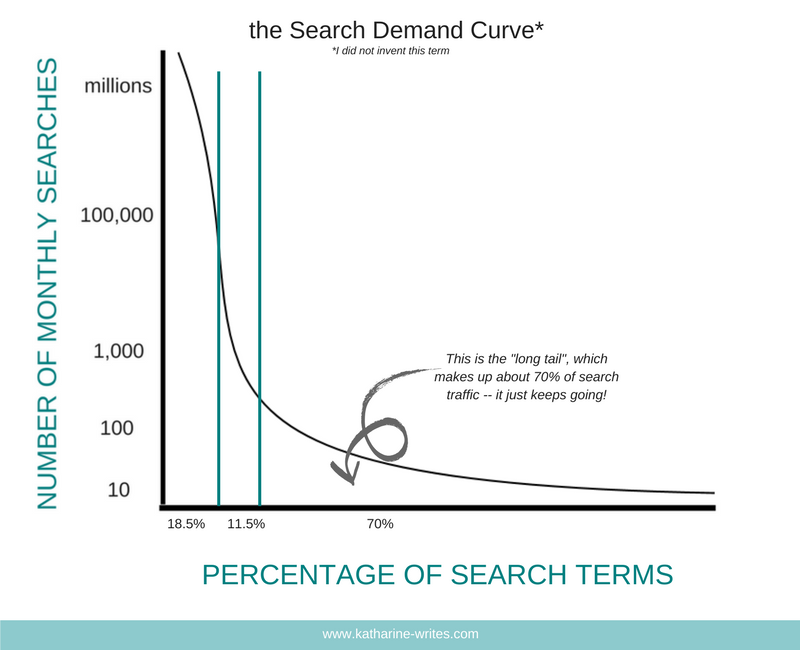
In other words, these terms are not searched as frequently as something like “travel” or “pajamas” because they are highly specific. They are the type of search term used by a customer who knows exactly what they are looking for.
There is also a lot less competition for them from other businesses and websites, meaning it is easier to rank high in search results for these terms.
This is great news for small businesses.
When you use content marketing to target long-tail keywords that are specific to your business, you can attract customers who are looking for exactly what you are selling.
And when you use dozens — or even hundreds — of long-tail keywords, you increase your chances of attracting even more buyers.
Which brings us back to LongTailPro.
Is LongTailPro worth the investment?
LongTailPro is one of the most popular keyword researchers on the market. But it is an investment. (Though, if you keep reading or jump down, you’ll find a 30% discount just for you!)
If you’ve never used it before, or if you’re new to content marketing and keyword researching, you’ll want to know if it’s worth that investment before you dive in.
In this post, I’m going to look at:
- Tutorial: how to use LongTailPro
- Review: the pros and cons of LongTailPro, including cost and ease of use
- Honest assessment: is this is an investment that makes sense for small business owners?
- Special offer: how to get a free trial + 30% off
(You can click on any of those links above to jump to those sections of the post, or just keep reading to see all of them!)

LongTailPro Keyword Researching Tool Review
Who can use LongTailPro?
Honestly, anyone who has a computer. The technical requirements for using LTP are:
- Adobe Air, a free software that runs on both Mac and Windows computers, which you can find here.
- A Google Adwords account, which is free to set up here.
- A Moz API* account, which is also free and available here.
- A computer that is… relatively new. If it’s older than five years, you may have trouble running the software, simply because of size. (But I think most of us have computers that fall in that category.)
That’s it in terms of software and hardware requirements.
But who is this software actually for?
Most reviews will tell you that LongTailPro is for affiliate marketers. And that’s not wrong! Affiliate marketers can definitely use this software, and many of them do.
But they’re not the only ones! Other people who can use LongTailPro include:
- businesses that want to improve their search engine optimization
- companies that use pay-per-click ads
- anyone who uses content marketing
- bloggers who want to drive traffic
- niche websites that want to attract interested readers
Really, if you want customers or readers to type a question into a search engine and end up directed to your website, LTP is relevant to your business.
So now you know if you could use LongTailPro.
But should you? And how does it work?
How to use LongTailPro
(If you want to follow along as I describe how to use LongTailPro, you can click here to start a free trial immediately.)
First, if you are using the downloaded version of LTP, they’ve put together a video to show you how to download and install the software, which you can see below.
The cloud version does have slightly more limited functionality than the full version. BUT I think that actually makes it ideal for beginners and small business owners who are just getting used to keyword research and content marketing.
I use the cloud version, and I honestly find that it does everything I need it to.
(If you aren’t ready for a tutorial yet, no problem! You can jump to the pros and cons or learn how to start a free trial instead.)
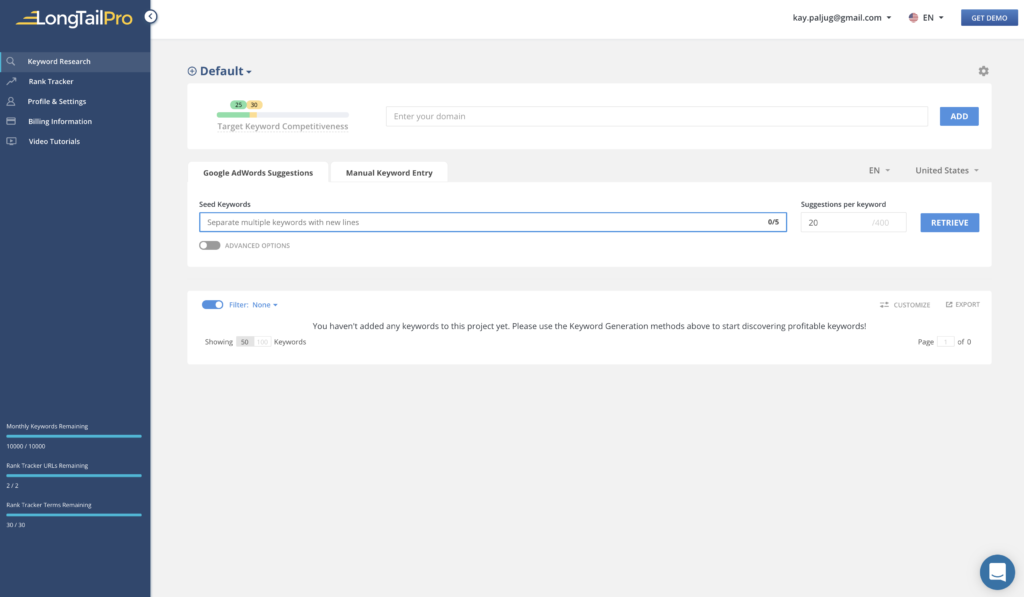
When you open LTP, you’ll see this screen as your default.
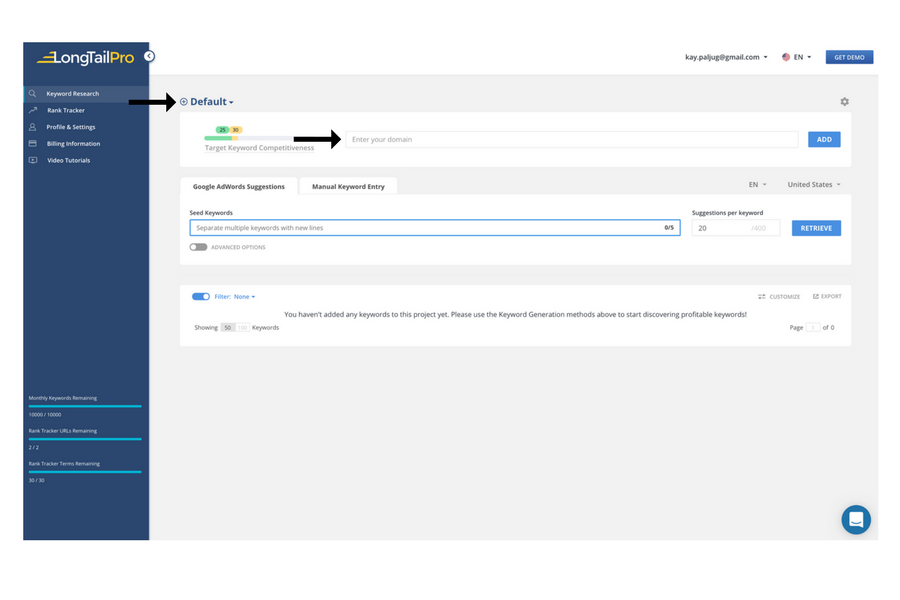
The first thing you’ll want to do is create a new project and tie it to your website. This allows you to keep your research organized and find keywords that are more targeted to your domain.
To create a new project, click the + next to “Default” and type in your project name. Then type in your domain URL where it says “enter your domain,” and click add.
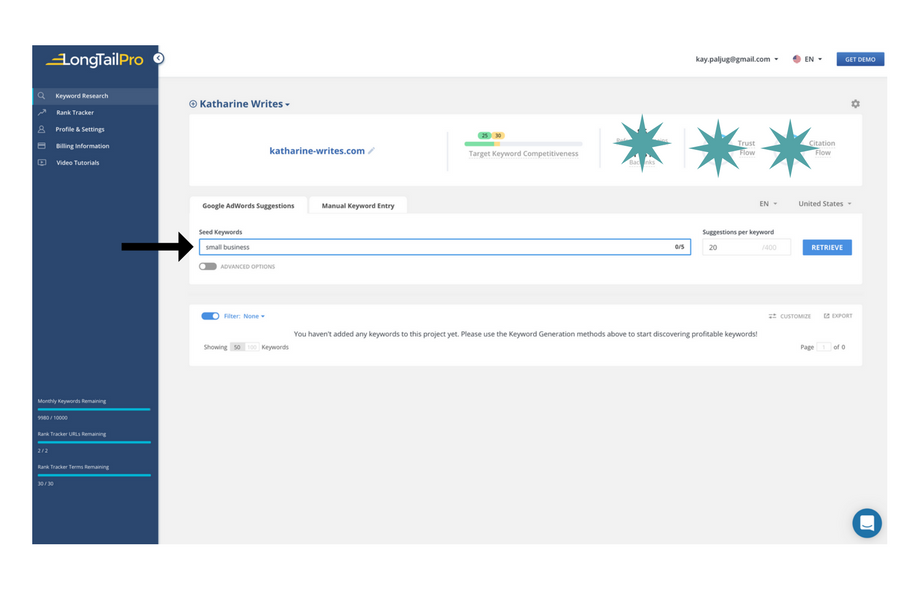
Start your keyword research by tying in a “seed keyword.” This is like your starter keyword — a term that broadly encompasses your business, niche, or product. Your goal is to find better, more usable keywords that are related to this seed. For my example here, we’re going with “small business,” since those are the people I love helping!
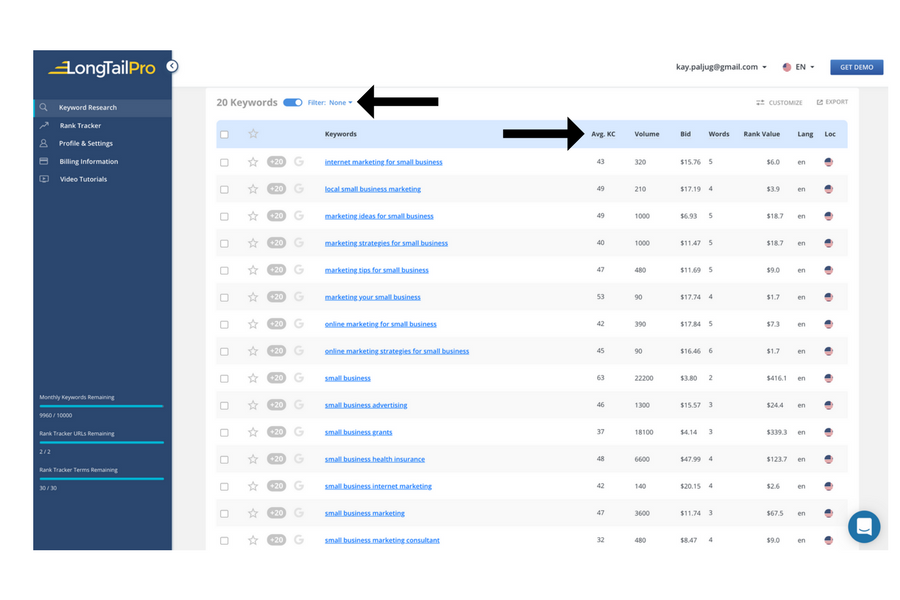
LTP will return a list of related keywords, categorized by a variety of metrics: Avg. KC (competitiveness); Volume (number of searches); Bid (suggested bid for AdWords); Words (how many words in the string); etc. This is the information you use to decide whether a keyword is a good fit for you or not.
You can also click the filter button at the top and select certain parameters. For example, you can choose to only see words above a certain search volume or only search terms made up of 4+ words.
That column labeled “Avg. KC” is one of the most helpful parts LTP, because it tells you exactly what is and is not worth your time. Here’s how it breaks down:
- 0 to 10: basically no competition at all
- 10 to 20: very low competition
- 20 to 30: low competition
- 30 to 40: moderate competition
- 40 to 50: mid-to-high competition
- 50-60: high competition
- 60 to 70: very high competition
- 70 to 100: ridiculous levels of competition
When you are using long-tail keywords for content marketing, you want to look for search terms that are low competition but still have decent search volume.
So let’s compare three terms from the list above:
“Small business” is clearly a frequently searched term, wth a search volume of 22,000. BUT is also has an average KC of 63, which is very high. This means a lot of websites already use this term, so it will be hard to rank for, and I’m better off not focusing on it exclusively.

“Small business grants” also has a high search volume, at 18,100. But it’s average KC is much lower, at 37, which puts it in the “moderate competition” range. This could be a good search term to keep in mind, especially if I pair it with other keywords that have lower volume but also lower competitiveness.
“Small business ideas for men” doesn’t have a huge search volume. But it is very low competitiveness (which is why LTP highlights it in yellow). Paired with terms like “small business ideas” and “small business ideas for women,” it would probably make for a well-trafficked blog post.
If your business uses pay per click (PPC) advertising, you’ll also want to pay attention to the Bid column. This, combined with Average KC and Volume, tell you whether a keyword is worth investing in for advertising, how many people are likely to use it, and how much it will probably cost you to bid on that keyword for PPC purposes.
You can also select a different country in the far column (where you see the little American flag above) if you want to target keywords that people in other parts of the world are searching for.
You can plug in as many seed keywords as you want — and you should plug in a lot! — to find the best search terms for your website. The more long-tail keywords you have to work with, the more content you can create, which means better content marketing and search engine optimization.
Of course, if you want to use those keywords, you need to organize them, right?

If you click the check box next to a keyword, several options will appear at the top of the list. To create a clean list, you can delete keywords that you know you aren;t going to use by clicking “Delete Keywords.” You can also organize them into targeted lists by selecting a few keywords and clicking “Move to Project.”

You can use projects to organize keywords for specific blog posts, web pages, campaigns, products, or whatever system makes the most sense for your business.

Once you’ve organized you keywords, you can view them by scrolling back up to the top of the page and clicking on the upside down arrow next to the project name.

And you can even export your list by clicking the “Export” logo at the top of the list. This allows you to share your keywords with your team, use them on the go, send them to a consultant, or really organize them in whatever way makes the most sense for you and your business.
If at any point you have trouble using LongTailPro or have a question about how to perform a specific action, the company has you covered.
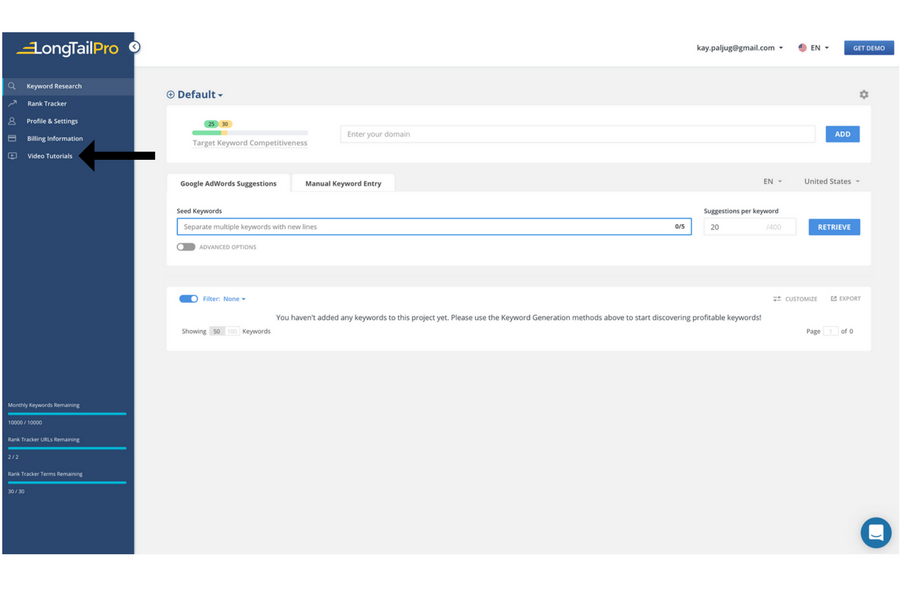
In the left sidebar menu, you’ll find an option labeled “Video Tutorials.” This takes you to the LongTailPro Bootcamp, 14 videos that walk you step by step through how to use the software, including more advanmced options once you’ve mastered the basics of keyword research.
There is also a chat option in the bottom right corner that will connect you with a customer service representative.
Okay, I know that was a lot of information!
But hopefully you can see now that, while keyword research may seem complicated at first, LongTailPro can actually make it quite straightforward!
There is a significant time investment, but that’s true for any kind of good marketing strategy. And like any good marketing strategy, that investment can really pay off.
Pros and cons of LongTailPro
So what do I think of LongTailPro overall?
First, as I’ve said, this is a tool I’ve used, both for myself and for clients. So it is one that I can endorse and recommend.
But as with any product, your unique situation may vary, and there are pros and cons to consider before you dive in and make a purchase.
Pros of using LongTailPro
- Ease of use. I find the whole process of using LongTailPro very straightforward compared to other keyword researching tools I’ve used.
- Depth of information. LongTailPro shows you a lot of valuable metrics, including competitiveness. A lot of free keyword researchers will show you search volume and bid information, but not how competitive a long-tail keyword is.
- Search volume. You can find a lot of keywords very quickly, which is incredibly valuable if you’re doing any kind of content marketing. And if you use PPC, LongTailPro lets you research a ton of keywords and compare them in one spot before you bid on any of them.
- Streamlined system. You can really get everything done that you need to in one spot, then share it all with your team. And if you don’t have a team, it makes it easy to get keyword research done on your own.
- Unlimited projects and domains. If you have multiple marketing campaigns or run more than one website, no problem. You can add as many as you need to.
- Good customer support. If you’re having trouble with a feature, there are a lot of ways to get help, and the software is frequently updated to keep it as useful as possible.
Cons of using LongTailPro
- Cost. This is the biggest con to a lot of people. Since the company changed to a monthly subscription-only model at the beginning of 2018, the cost for using LTP has gone up significantly. If you’re brand new to content marketing and aren’t sure whether it’s a good choice for your small business, you might hesitate use a monthly subscription tool.
- Feature availability. I prefer to use the cloud version, because I find it streamlined and simple. But there are a few features that aren’t available here, such as checking keyword ranking for major search engines. You’ll need to download the software to do this.
- Lots of hype. This doesn’t turn me off, because if a product is good, it’s good. But for some people, the fact that lots of “gurus” are constantly marketing this may make them hesitate. And I get that. The danger of groupthink is always there, but I don’t think that’s the case in this situation.
- Free versions available. For some users, the fact that there are free keyword tools available is always going to mean that they don’t want to pay for one. And that’s a valid choice for a business owner to make.
Is LongTailPro worth it for small business owners?
So given all that information, is LongTailPro a worthwhile investment for small business owners?
In my opinion, yes.
And I’m not just saying that because I want more people to use content marketing! I’m saying that because I’ve seen it work.
One of the most successful clients I’ve worked with was a healthcare startup that wanted to use content marketing to promote their new service packages. Their big marketing strategy was to dive headfirst into informational articles, which required a ton of keyword research.
Using LongTailPro, we worked together over the course of a year to constantly research, evaluate, and reevaluate health-related long-tail keywords and create an entire content hub of healthcare advice. Each new article had one main keyword, plus 2-4 related keywords.
Their content hub immediately optimized their website for search, and within just a couple months they were ranking at the top of Google searches for one out of every four keywords — and for most of the others they were on the first page of search results.
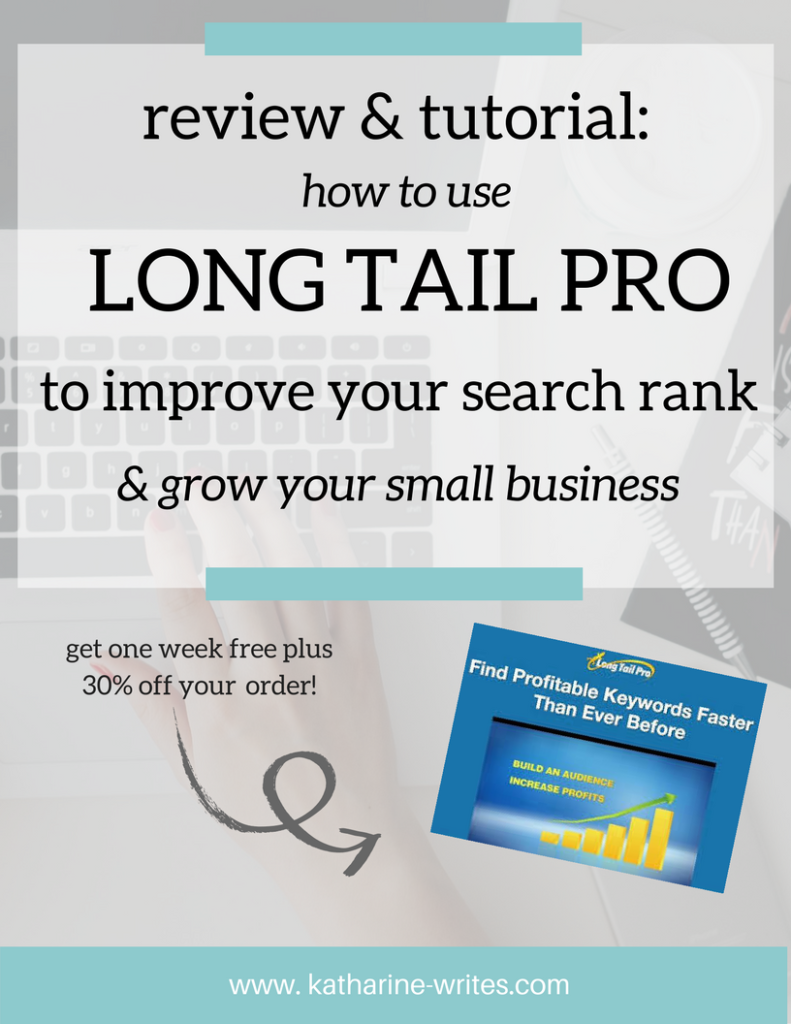
So, I’ve seen firsthand how successful content marketing can be for promoting a small business and how integral keyword research is for that process. This is true for:
- businesses that want to improve their search engine optimization
- companies that use pay-per-click ads
- bloggers who want to drive traffic to their website
- niche sites that want to attract interested readers
- anyone who is online — content marketing can work for everyone!
Honestly, I think one of the main reasons that businesses aren’t successful with content marketing is because they don’t understand what keywords to focus on. They focus on keywords like “test” or “hotel,” and when that doesn’t work they conclude that content marketing isn’t a good idea.
If you’re going to commit to a marketing strategy, you need the tools that will make that strategy successful.
LongTailPro is one of those tools, and it’s one that I think most businesses can really benefit from using.
Discount on LongTailPro
Ready to get started on your keyword research and rock your content marketing?
Then I’ve got great news for you: I’ve got a free trial and a discount code just waiting for you to use!
There are three plans available for LongTailPro:
- Annual Starter Plan: $47 per month
- Annual Pro Plan: $67 per month
- Annual Agency Plan: $147 per month
I usually recommend that small businesses or those newer to content marketing stick with the Starter Plan (you can always upgrade if you decide you need to unlock a few more features). And if your keyword research increases your sales by even just $94 per month… well, you’ve already made back twice what you spent!
But being a small business owner myself, and knowing how tight budgets can sometimes be, I’d like to get you an even better deal than that.
Right now, if you use the code KW30 at checkout, you get a whopping 30% off your LongTailPro subscription!
That discount code means your costs can now be:
- Annual Starter Plan: $31 per month
- Annual Pro Plan: $45 per month
- Annual Agency Plan: $98 per month
That’s a huge savings!
Or, if you’re not sure you’re ready to commit, you can try out LongTailPro for free! Not a joke: completely free.
You can start your 7-day free trial right here. And remember to use KW30 at checkout to save 30% off every month for the life of your subscription.
Yes, when you’re a small business owner, it can be scary to invest in a new tool.
But I’ve seen firsthand how content marketing can help businesses of all sizes grow their audience, improve their search engine rank, and increase their profits.
LongTailPro is a tool that can really help you make all that happen. It takes the guesswork out of planning your content marketing, and I can’t think of a single business owner who would say no to that!
Try it out for yourself completely free (and get 30% off every month with the code KW30).
Do you have experience with content marketing? Any questions about getting started with keyword research? Let me know in the comments!
This is not a sponsored post, and I was not compensated by LongTailPro for my opinions. However, this post does contain affiliate links, which not only help me out, they also give you 30% off your subscription! You can read my full disclosure for more info.
Thankss for share this awsm article…